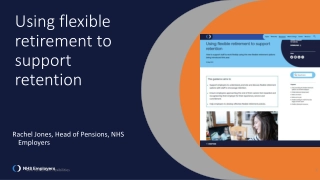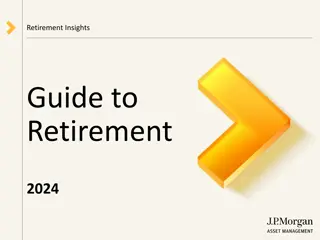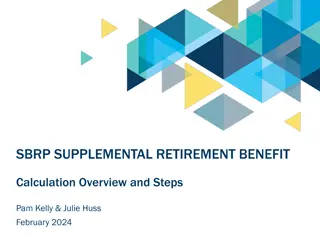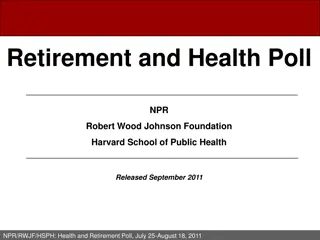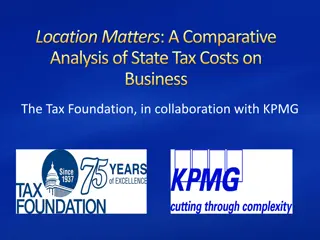Social Security and Tax Planning Before and During Retirement
Key decisions regarding Social Security and tax planning before and during retirement are discussed by Mike Piper, CPA. The factors to consider include when to file for Social Security, Roth conversions, and spending from different accounts each year. Understanding actuarial math, longevity risk, and tax planning are crucial in making informed decisions about Social Security filing age and maximizing benefits over a lifetime.
Download Presentation

Please find below an Image/Link to download the presentation.
The content on the website is provided AS IS for your information and personal use only. It may not be sold, licensed, or shared on other websites without obtaining consent from the author.If you encounter any issues during the download, it is possible that the publisher has removed the file from their server.
You are allowed to download the files provided on this website for personal or commercial use, subject to the condition that they are used lawfully. All files are the property of their respective owners.
The content on the website is provided AS IS for your information and personal use only. It may not be sold, licensed, or shared on other websites without obtaining consent from the author.
E N D
Presentation Transcript
Social Security and Tax Planning Before and During Retirement Mike Piper, CPA https://michaelrpiper.com/ https://obliviousinvestor.com/
Key Decisions Key Decisions 1. When should I file for Social Security? 2. Should I be doing Roth conversions? 3. Which accounts should I spend from each year?
Key Decisions Key Decisions 1. When should I file for Social Security? 2. Should I be doing Roth conversions? 3. Which accounts should I spend from each year?
When to File for Social Security? When to File for Social Security? Three Major Factors: 1. Actuarial math 2. Longevity risk 3. Tax planning
When to File for Social Security? When to File for Social Security? Three Major Factors: 1. Actuarial math 2. Longevity risk 3. Tax planning
When to File for Social Security? When to File for Social Security? Actuarial Math: Which filing age(s) would be expected to provide the greatest total benefits over my/our lifetime? More specifically, present value of total benefits. Accounting for inflation. Accounting for the fact that benefit dollars received sooner can be invested.
When to File for Social Security? When to File for Social Security? This actuarial math is exactly what Open Social Security does.
When to File for Social Security? When to File for Social Security? Single: file at (or close to) 70. Reason: Longer life expectancies, which favors delaying. Exceptions (reasons to file early) Poor health Minor child or adult disabled child Real interest rates are high
When to File for Social Security? When to File for Social Security? Married: Higher earner files at 70. Lower earner files earlier. Reason: Survivor benefit rules. Once either spouse dies, the survivor generally keeps getting the larger of the two benefit amounts. (Smaller amount goes away.)
When to File for Social Security? When to File for Social Security? When higher earner delays, increases household benefit for as long as either person is alive (i.e., until both people have died). Longer time When lower earner delays, increases household benefit for as long as both people are alive (i.e., until one person has died). Shorter time
How Long Until Both People Have Died? Spouse A lives beyond life expectancy. Spouse B lives beyond life expectancy.
How Long Until Both People Have Died? Spouse A lives beyond life expectancy. Spouse B lives beyond life expectancy. Spouse A dies early. Spouse B dies early.
How Long Until Both People Have Died? Spouse A lives beyond life expectancy. Spouse A dies early. Spouse B lives beyond life expectancy. Spouse B lives beyond life expectancy. Spouse A dies early. Spouse B dies early.
How Long Until Both People Have Died? Spouse A lives beyond life expectancy. Spouse A dies early. Spouse B lives beyond life expectancy. Spouse B lives beyond life expectancy. Spouse A lives beyond life expectancy. Spouse A dies early. Spouse B dies early. Spouse B dies early.
How Long Until Both People Have Died? Spouse A lives beyond life expectancy. Spouse A dies early. Spouse B lives beyond life expectancy. Spouse B lives beyond life expectancy. Spouse A lives beyond life expectancy. Spouse A dies early. Spouse B dies early. Spouse B dies early.
How Long Until Both People Have Died? Spouse A lives beyond life expectancy. Spouse A dies early. Spouse B lives beyond life expectancy. Spouse B lives beyond life expectancy. Spouse A lives beyond life expectancy. Spouse A dies early. Spouse B dies early. Spouse B dies early.
How Long Until Both People Have Died? Spouse A lives beyond life expectancy. Spouse A dies early. Spouse B lives beyond life expectancy. Spouse B lives beyond life expectancy. Spouse A lives beyond life expectancy. Spouse A dies early. Spouse B dies early. Spouse B dies early.
When to File for Social Security? When to File for Social Security? Roughly 3/4 chance at least one person lives beyond life expectancy. This is why it is advantageous for higher earner to delay.
How Long Until One Person Has Died? Spouse A lives beyond life expectancy. Spouse A dies early. Spouse B lives beyond life expectancy. Spouse B lives beyond life expectancy. Spouse A lives beyond life expectancy. Spouse A dies early. Spouse B dies early. Spouse B dies early.
How Long Until One Person Has Died? Spouse A lives beyond life expectancy. Spouse A dies early. Spouse B lives beyond life expectancy. Spouse B lives beyond life expectancy. Spouse A lives beyond life expectancy. Spouse A dies early. Spouse B dies early. Spouse B dies early.
When to File for Social Security? When to File for Social Security? Roughly 3/4 chance at least one person dies before reaching life expectancy. This is why it is often advantageous for lower earner to file earlier.
When to File for Social Security? When to File for Social Security? Rough draft plan: Higher earner files at 70. Lower earner files earlier.
When to File for Social Security? When to File for Social Security? Exceptions: Minor/adult-disabled child. (Maybe higher earner files earlier.) Lower earner still working. (Wait until year that person stops working, or FRA.) Government pension. (Could affect decision in either direction.)
When to File for Social Security? When to File for Social Security? Exceptions: Both spouses very poor health. (Higher earner files before 70.) Both spouses in very good health or concerned about longevity. (Lower earner waits longer.) Tax planning. (Usually a point in favor of waiting, but could go either direction.)
When to File for Social Security? When to File for Social Security? Three Major Factors: 1. Actuarial math 2. Longevity risk 3. Tax planning
When to File for Social Security? When to File for Social Security? Longevity risk: risk of outliving your money Delaying is usually the best decision from this point of view. However, some people have essentially no longevity risk already.
When to File for Social Security? When to File for Social Security? Three Major Factors: 1. Actuarial math 2. Longevity risk 3. Tax planning
When to File for Social Security? When to File for Social Security? Tax planning: usually a point in favor of delay. Social Security benefits are (at least) partially tax-free. Gives a longer window of time for Roth conversions.
When to File for Social Security? When to File for Social Security? How I actually do this for clients: 1. Use Open Social Security to see the actuarially-best strategy. 2. From a tax or longevity risk point of view, would we prefer lower earner to wait? 3. How does expected PV change if we push lower earner s filing date later?
Key Decisions Key Decisions 1. When should I file for Social Security? 2. Should I be doing Roth conversions? 3. Which accounts should I spend from each year?
Roth Conversions Roth Conversions What s a Roth conversion? Moving money from tax-deferred to Roth. Generally taxable as income.
Roth Conversions Roth Conversions Why (and when) would you do a Roth conversion? When you have a temporarily low tax rate, convert and pay tax now at that low rate to avoid paying tax later at a higher rate. Current marginal tax < future tax rate? Do a Roth conversion.
Roth Conversions Roth Conversions Caveats & Considerations
Roth Conversions Roth Conversions This is not a binary decision (i.e., convert whole IRA or not). This is a dollar-by-dollar analysis, repeated each year. Often the answer for a given year is to do conversions up to a certain income threshold.
Roth Conversions Roth Conversions Marginal tax rate is not always the same as tax bracket! Premium tax credit Social Security taxation Medicare IRMAA 3.8% net investment income tax Anything that phases in or phases out based on income
Roth Conversions Roth Conversions Marginal tax rate is not always the same as tax bracket! DIY tax calculations are often wrong. Use tax software.
Roth Conversions Roth Conversions Marginal tax rate often increases after one spouse dies. Reason: Standard deduction as large. Tax brackets have as much room in them (through 32% bracket). But income falls by less than 50%. Implication: may want to prioritize Roth conversions while both spouses are still alive.
Roth Conversions Roth Conversions Future tax rate may not be your future tax rate. It could be the tax rate your heir(s) would pay on distributions from an inherited IRA. To the extent you plan to leave tax-deferred dollars to charity, it s zero!
Key Decisions Key Decisions 1. When should I file for Social Security? 2. Should I be doing Roth conversions? 3. Which accounts should I spend from each year?
Which Accounts to Spend From? Which Accounts to Spend From? Tax-deferred (a.k.a. traditional or pre-tax ) Roth Taxable (anything that isn t a retirement account)
Which Accounts to Spend From? Which Accounts to Spend From? Example Which dollars to use for next $1,000 of spending? Haven t yet used up standard deduction for the year (0% tax rate).
Which Accounts to Spend From? Which Accounts to Spend From? $1,000 left in taxable account (checking) Option A Spend $1,000 from tax-deferred. Option B Spend $1,000 from taxable account (checking/savings). Do $1,000 Roth conversion. $1,000 left in Roth In both cases: Spent $1,000. Created $1,000 of income, but $0 tax. $1,000 less in tax-deferred than previously.
Which Accounts to Spend From? Which Accounts to Spend From? $100k left in taxable (checking) Option A $100,000 out of tax-deferred for spending. $25,000 of tax (25% rate). Spend $75,000. $100k left in Roth Option B Spend $75,000 from checking. Do $100,000 Roth conversion. (Pay $25,000 tax from checking.) In both cases: Spent $75,000 on living expenses. Created $100,000 of income, paid $25,000 tax. $100,000 less in tax-deferred than previously.
Which Accounts to Spend From? Which Accounts to Spend From? Every year: spend checking account dollars first Earned income Social Security Pension/annuity income, Interest and dividends from taxable accounts RMDs Assets in taxable accounts with unrealized losses or modest gains. (Low/no tax cost to sell.)
Which Accounts to Spend From? Which Accounts to Spend From? Before spending from retirement accounts, spend any assets from taxable accounts for which there would be no (or very little) tax costs. Fill up low-tax-rate space with a Roth conversion instead!
Which Accounts to Spend From? Which Accounts to Spend From? Roth vs. Tax-deferred spending Overall approach: Current marginal tax rate < future marginal tax rate? Spend tax-deferred. Current marginal tax rate > future marginal tax rate? Spend Roth.
Which Accounts to Spend From? Which Accounts to Spend From? Roth vs. tax-deferred question for spending is the same as the Roth conversion question! Not a binary decision. (Dollar-by-dollar decision.) Marginal tax rate is not the same as tax bracket. Marginal tax rate often increases after one spouse dies. Future tax rate may be somebody else s future tax rate (heirs or charity).
Which Accounts to Spend From? Which Accounts to Spend From? 1. Taxable assets are the first priority for spending each year. Checking, savings, taxable brokerage assets with no tax-cost to sell. (All taxable assets that aren t highly appreciated.) 2. If you need to spend more in a given year: Spend Roth if current marginal tax rate > future marginal tax rate. Spend tax-deferred if current marginal tax rate < future marginal tax rate. 3. Fill any remaining low-tax-rate space with Roth conversions.
Social Security and Tax Planning Before and During Retirement Mike Piper, CPA https://michaelrpiper.com/ https://obliviousinvestor.com/


